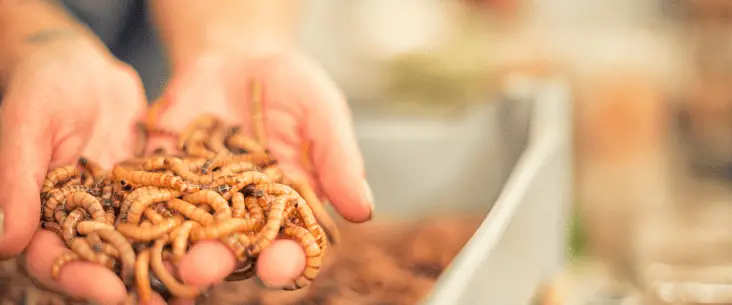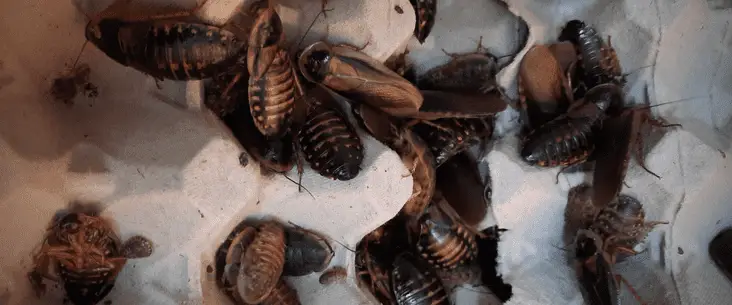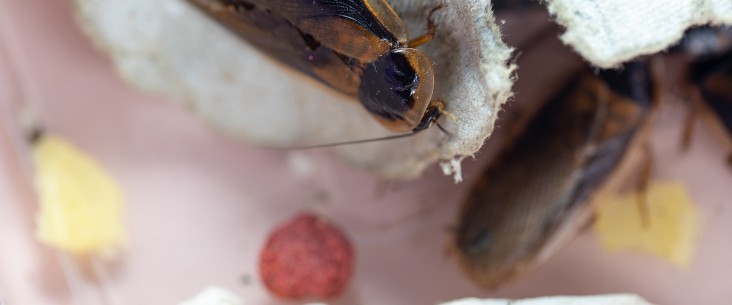So you bought a box full of feeder crickets at the pet store or online breeder to feed your pet animals. But, by the time you want to feed them some of the crickets died already. And within a few days, the rest of them died as well. This happens to many keepers that want to start feeding crickets (and for almost any feeder insect for that matter). Now, let me tell you three simple steps to keep your feeder crickets alive much longer.
To keep crickets alive much longer you need to provide moist food so they can rehydrate as soon as possible, keep them in a bigger container than the transport box and feed them with other healthy food. Optimize and provide a clean environment and avoid overpopulation.
In this article, we will focus on how to house crickets before feeding them. It is just a matter of some small changes that keep them healthy and make them live much longer. If you found this article but you want to breed your own crickets, I recommend you to read this breeding guide for feeder crickets. It is packed with tips and tricks on how you can make the perfect breeding setup.
We partner with companies that offer products that we think are great for you to use, and that can help you achieve your goals. If you purchase through our partner links, we get paid for the referral at no additional cost to you! Please read our disclaimer for more info.
#1 Rehydrate your crickets right away
One of the first things you should do when you bought or received new crickets from the store is hydrate them. Imagine that they don’t have any water source since they left the cricket breeder. They are kept dry in a box and it may take up to two weeks from the breeder to your home. Most time your crickets are completely dehydrated and without a source for water, they will die within a few days.
Dehydration is the number one reason your crickets die sooner than you can feed them. So you’ll need to provide a water source right away when you have them home. The best way is to provide moist food such as banana peels, an orange slice or a piece of apple.
Don’t place a water bowl or bottle cap filled with water in the container. Crickets can’t swim and although attracted to the water will quickly drown, especially the smaller ones. Don’t spray the cricket enclosure either. They need a dry environment and spraying makes the container pretty wet which is unhealthy and bad for crickets.
Have moist food in the container at all times so your crickets are kept well hydrated. With this simple little trick, your crickets will survive already much longer. However, you can improve their well being even further. Let’s talk about tip #2.
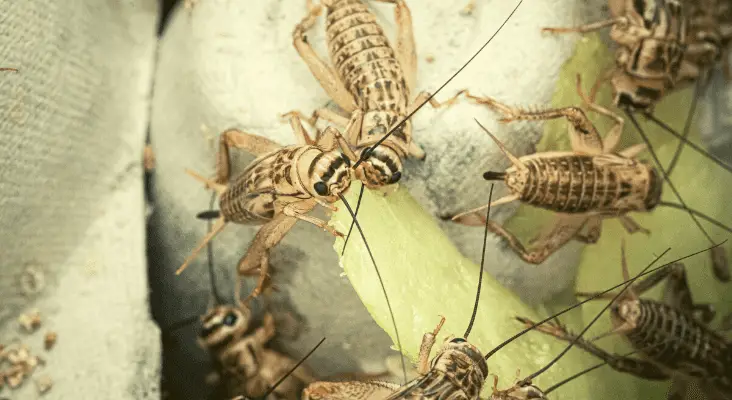
#2 House your crickets in a bigger tank
The second thing you should do, especially when you don’t feed them all within 5 days, is place them in a bigger container. Now I always recommend placing them in a bigger container because they just stay better that way and for you, it is much easier to work with them.
The second cause that reduces feeder cricket lives is overpopulation — or in other words too many crickets on a small surface. On one hand, you can place them in a larger box. So-called ‘Faunariums’ work really well to keep crickets. The one that I personally recommend is Lee’s Kritter Keeper that you can quickly order on Amazon. They just work perfectly and are not that expensive.
For the size of the container, the general rule of thumb is that you have at least 1 gallon for every 100 crickets. However, I personally go bigger to make sure overpopulation is not an issue.
You could also use plastic storage containers with semi-transparent smooth walls and a lid that closes off perfectly without space for them to escape. But keep in mind that crickets need good ventilation and you have to make some ventilation holes and cover them with a fine metal screen mesh. Without proper ventilation, they won’t survive for long.
On the other hand, it is best to increase the surface space in the container. Use some paper toilet rolls, folded cartons, egg boxes or egg flats to increase the surface area for them to crawl away. They like dark spaces and with a lot of shelters, it is less likely overpopulation within the container results in problems.
Avoid using ‘cricket keepers’ or ‘cricket pens’. On first hand they look easy and perfect to use, but after a while you find out that those tubes mounted in the container is not working well. Crickets tend to all crawl in these tubes where the furthest crickets don’t have much ventilation and can’t access food easily. You actually create mini overpopulated areas. Besides that, crickets are cannibalistic and when they don’t have easy access to food in combination with overcrowded areas they tend to eat each other.
#3 Provide nutritious food to keep them healthy
The third important thing to do is provide nutritious food to your crickets. This is important for two reasons actually. First and obviously, good food keeps your crickets healthy which makes them live longer. But there is a second reason: You not only want the cricket itself to be healthy, but they also need to be healthy food for the animals you want to feed them. We call that gut-loading. This is a whole other topic and I’ve written an extensive guide on how you can gut-load your feeder insects to make them more nutritious food for others.
But what should we feed our crickets then? We have mentioned before that a variety of moist food should be provided at all times to keep them well-hydrated. This includes food such as bananas (peels), apples, oranges, pears, watermelons, cucumbers, and grapes. Now, these products need to be refreshed when dried out, so change them every 2 or 3 days.
Additionally, it is good to feed your crickets high protein food such as oatmeal, cornmeal, chicken meal or high protein fish flakes. This food needs to be provided dry and away from the fresh food so it will not get damp or mouldy. It is best to feed both types of food in different bowls and place each in another corner away from the other.
Recommended read: How To Keep Feeder Locusts Alive Much Longer In 4 Easy Steps
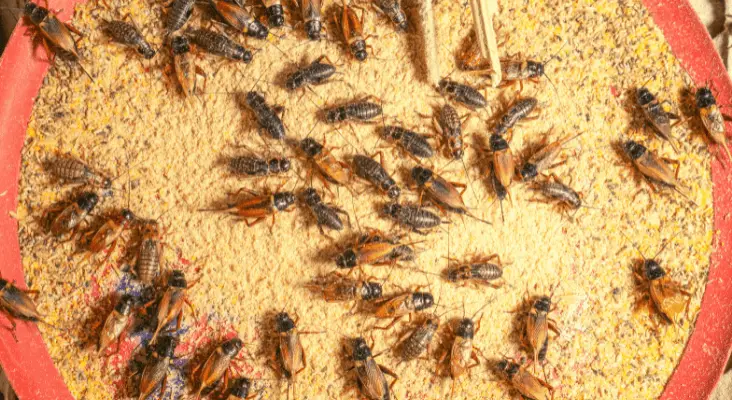
Additional tips to keep crickets healthy
We have discussed the three most important factors to keep your crickets alive longer before you feed them to your other animals. However, there are more tips that may be valuable to you when using feeder crickets.
Crickets need a clean environment
Crickets like a clean environment and do much better when you have a regular cleaning routine. So start off by replacing any dirty and/or moist cartons with new ones. Do this at least every time you place a new batch of crickets in the container.
Refresh food regularly so that it has not the chance to rot or attract mould. Check daily on dead crickets and if you find any dead cricket, remove them immediately before other crickets start eating them.
Also, rinse the container with water thoroughly and air dry it every time you receive new crickets. NEVER use any soap or chemicals for cleaning, because this quickly kills all your crickets.
When keeping crickets in a clean environment helps increase their longevity and reduce the risk of mould or diseases. Remember that these creatures are actually a food source for others, so make sure they are fresh and healthy before feeding to other animals.
Decrease the smell of crickets
Do crickets smell? It depends per person: not every person thinks it smells. But crickets produce certain smells that you can reduce. One of the things that create that smells is the food you provided that had laid for a (too) long in the container. Near rotten fruit and vegetables when they are warm don’t smell that nice.
Another way to reduce the smell of crickets is by placing a substrate layer of vermiculite in the container. Vermiculite has the ability, among other things, to absorb the strange smells crickets and their food produce. So if you are bothered by the smell of crickets, just add some vermiculite and it probably improves the smell a lot.
Optimize the environmental conditions
Now we talked a lot about how you should keep your crickets, but there are some aspects that you can improve to make them even happier. First, place your crickets where there is not much disturbance like vibration and a lot of light. Crickets enjoy the quiet and more dark spaces. Besides that, crickets can make a heck of a noise and you don’t want that in your living room or bedroom, do you?
But one other thing you can improve is the temperature. Crickets like it hot and dry, so some additional heat can make your crickets even happier. You can add a heating pad on the backside of the container, or place a dark (ceramic) heat lamp above the container. In both cases place the heat source outside of the container and check if you do not make it too hot. Crickets survive within temperatures of 13°C up to 35°C (55°F-95°F), but the optimum temperature is between 27°C and 30°C (80°F-86°F).
Don’t place the crickets in front of a window. Besides that it provides a lot of light, sunlight can heat up the container and raise the temperature inside to levels that are deadly for crickets. You can almost literally roast your crickets when placed in sunlight. Also, being close to windows gives a lot of temperature fluctuation, and it is much better to house crickets in a stable environment. And when you open a window or when your window has ventilation, a colder draft can cool your enclosure as well. I think you get the point.
Don’t keep crickets with other feeder insects
I sometimes receive the question if you can keep crickets together with other feeder insects. I can be very short with that: the answer is NO. Crickets are not good company for other insects. They are quite cannibalistic and eat their own eggs or smaller crickets when they have hungry, so with other feeder insects, it probably ends up the same. Crickets are voracious eaters and try to eat others when they have the chance.
The general advice is to keep all feeder insects in their own containers. Especially when you want to breed them. Another reason you don’t want to keep different feeder insects together is because of diseases and cross-contamination. This is not only true for different feeder insects, but also for different populations of the same feeder insects. Imagine adding a new batch of crickets to your old one, but that there is a virus or parasite living among your current crickets. The result will be they all get infected and die in a short time.
So my advice: always keep crickets, and even different batches or populations of crickets, in their own enclosure. Read more about this topic in the article I’ve written about cross-contamination.
Why do my crickets keep dying?
Are you still see (too many) crickets die? And you are sure it is not of old age (generally feeder crickets get around 3 months old)? If you have done most of the things written in this article they normally don’t die that quickly. Here we describe other causes that may kill your crickets.
- Too much moisture — Crickets need a dry environment and too much moisture is bad for crickets. Although we think it is dry, we humans are not good at perceiving humidity. You could place a humidity reader close to or in the container to see the humidity. Also, replace cartons more often because this will slowly fill with moisture. Placing vermiculite at the bottom of the container not only reduces the smell of the enclosure but also absorbs moisture and decreases the humidity in the container.
- Ventilation and/or overpopulation — We already mentioned that ventilation in combination with too many crickets in one space can lead to dead crickets. Make sure you have provided enough space, didn’t add too many crickets, added egg flats and toilet paper rolls, and have good ventilation at both the top and the sides of the container. You quickly tend to keep too many crickets in a container that has not enough ventilation capacity.
- Viruses and parasites — It is not much you can do but viruses or parasites can manifest in your cricket population. You can reduce the risk of this by keeping the environment clean, don’t combine different cricket batches together and working clean. When a virus or parasite manifests in your cricket population the animals quickly die altogether. When this happens is a clear sign that at least clean and not use that container for a while and clean it thoroughly before adding new crickets in it. Viruses and parasites can’t live long outside a host.

I hope this article helped you to keep your feeder crickets happy, healthy, and live (much) longer and that they provide a more nutritious food source for other animals. If you like this article and considering breeding crickets yourself, please read the guide on breeding crickets.
Other insects you can easily keep and breed at home!
On this website we talk a lot about feeder insects. Check out our general guide on feeder insects. Besides crickets, there are several other feeder insects that you can easily keep and breed at home so you don’t have to buy them again. Check out the breeding guides for the following feeder insects and maybe you can start your own breeding with one of these:
– Crickets
– Locusts
– Dubia roaches
– Superworms
– Fruit flies
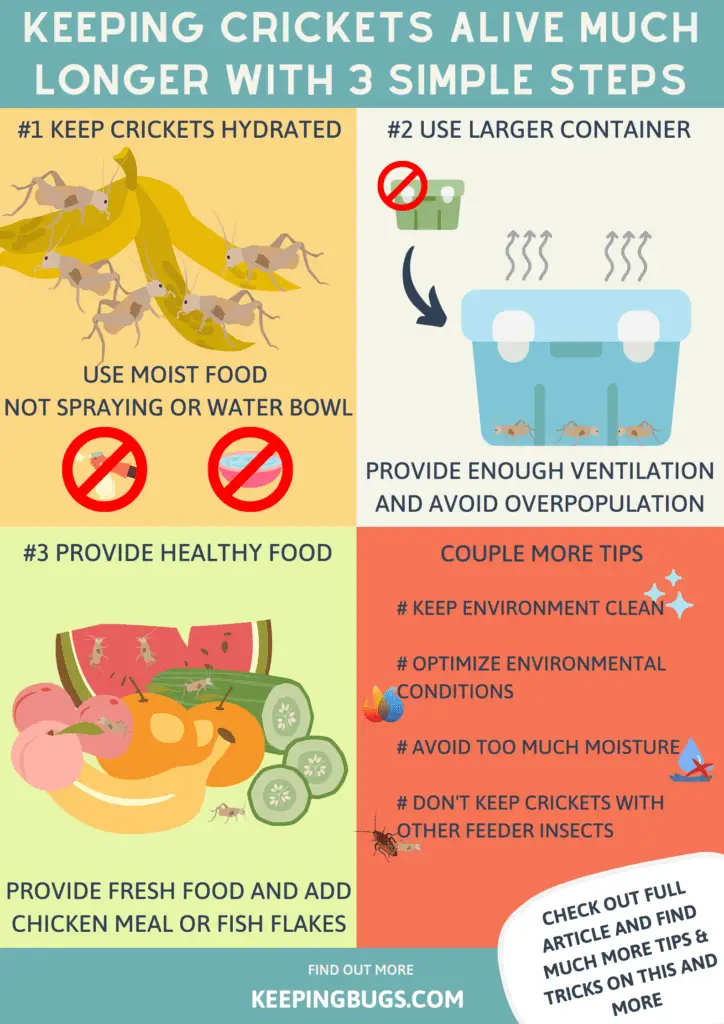
Share this page!

